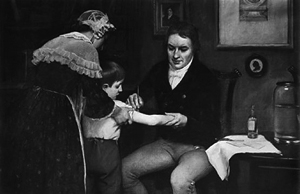 Edward Jenner’s discovery is considered to have saved more lives than the work of any other man. Edward Jenner’s great gift to the world was his vaccination for smallpox. Before Jenner’s work with the disease, smallpox was an extremely deadly illness. The disease killed one in three of those who caught it. Those who were lucky enough to survive the disease were greatly disfigured. Continue reading “Making History: Medical Advancements – The Discovery of the First Vaccination”
Edward Jenner’s discovery is considered to have saved more lives than the work of any other man. Edward Jenner’s great gift to the world was his vaccination for smallpox. Before Jenner’s work with the disease, smallpox was an extremely deadly illness. The disease killed one in three of those who caught it. Those who were lucky enough to survive the disease were greatly disfigured. Continue reading “Making History: Medical Advancements – The Discovery of the First Vaccination”

Category: A Moment in History
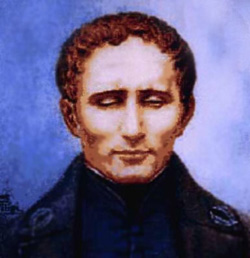 At the age of 3, Louis Braille accidentally poked himself in the eye with a stitching awl from his father’s workshop. The original injury was not very serious, but Louis went blind when the eye later became infected. That trauma then lead to the young boy going blind in his other eye, too.
At the age of 3, Louis Braille accidentally poked himself in the eye with a stitching awl from his father’s workshop. The original injury was not very serious, but Louis went blind when the eye later became infected. That trauma then lead to the young boy going blind in his other eye, too.
At 10, Braille was admitted to the National Institute for the Blind in Paris, the first school of its kind in the world. Students were taught basic craftsman skills and simple trade. They also had a system of teaching children to read by feeling raised letters made by pressing copper wire against paper. Publishers of these books often included numerous stories in one book to save money, causing the books to weigh as much as 100 pounds. Braille quickly read and mastered the 14 books available at the National Institute. While the method certainly helped become a proficient reader, the school had no system for teaching him to write as well. Continue reading “Stitching Awl Blinds Louis Braille, But Aids With Invention of Braille”
Well, for starters, all three were invented by accident.
It’s pretty amazing that these, like many other inventions, are the byproducts of a mistake or have uses that were not the original intention. Nonetheless they are now some of the most well known, popular and sometimes very important inventions. Continue reading “Mold Into Medicine? Discovery of Penicillian and Other Accidental Inventions”
 Carl Magee was a member of the Oklahoma City Chamber of Commerce Traffic Committee and was assigned the task of solving the parking problems in Oklahoma City. People that worked in the down area were parking on the streets all day which left very few spaces for shoppers and other visitors to the business district.
Carl Magee was a member of the Oklahoma City Chamber of Commerce Traffic Committee and was assigned the task of solving the parking problems in Oklahoma City. People that worked in the down area were parking on the streets all day which left very few spaces for shoppers and other visitors to the business district.
The solution would be to install parking meters that would charge for the use of parking spaces and force turn over of the spaces that would otherwise be filled all day by one car. The parking meters would also generate revenue for the city.
Magee built a crude model and then enlisted the help of the Oklahoma State University Engineering Department. A contest to built a working model ran from February 7 to May 6, 1933. Several students entered but there were no acceptable working submissions. Continue reading “Scrounge for Quarters – The Parking Meter Patent”
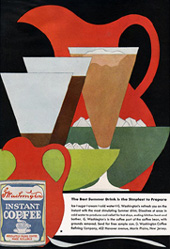 Everyone has at one point or another, drank a cup of instant coffee whether we wanted to or not. In 1901 – by many accounts on July 24 – Japanese American chemist Satori Kato invented instant coffee while living in Chicago. Kato had already invented soluble tea. He was later approached by a U.S. coffee importer and roaster about applying his method for dehydrating tea to coffee. With the help of an American chemist, Kato was successful. The same year, the Kato Coffee Company distributed free samples of its product at the Pam-American Exposition in Buffalo. The company had very little success with its new product. Very few liked the taste of the coffee and it was considered a novelty. Kato received U.S. Patent No. 735,777 on August. 11, 1903 for a Coffee Concentrate and Process of Making Same. Continue reading “Quick Cup of Joe? Invention of Instant Coffee”
Everyone has at one point or another, drank a cup of instant coffee whether we wanted to or not. In 1901 – by many accounts on July 24 – Japanese American chemist Satori Kato invented instant coffee while living in Chicago. Kato had already invented soluble tea. He was later approached by a U.S. coffee importer and roaster about applying his method for dehydrating tea to coffee. With the help of an American chemist, Kato was successful. The same year, the Kato Coffee Company distributed free samples of its product at the Pam-American Exposition in Buffalo. The company had very little success with its new product. Very few liked the taste of the coffee and it was considered a novelty. Kato received U.S. Patent No. 735,777 on August. 11, 1903 for a Coffee Concentrate and Process of Making Same. Continue reading “Quick Cup of Joe? Invention of Instant Coffee”
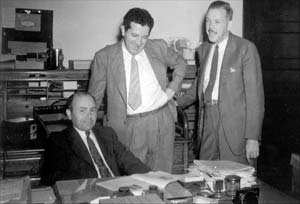 Marshmallow Peeps are a stable of Easter Baskets all over the country. This delicious or maybe disgusting candy is made from marshmallows, sugar, gelatin and caranauba wax. These sugary treats were brought to consumers on a large scale in 1954. But their story starts before that.
Marshmallow Peeps are a stable of Easter Baskets all over the country. This delicious or maybe disgusting candy is made from marshmallows, sugar, gelatin and caranauba wax. These sugary treats were brought to consumers on a large scale in 1954. But their story starts before that.
Russisan native Sam Born moved from France, where he learned to make chocolates, to the United States in 1910. In 1917, Born opened a small store in New York City selling chocolate and other confections. There he invented a machine for automatically placing sticks in lollipops. Continue reading “Easter Bunny Favors Marshmallow Chicks – The Invention of Peeps”
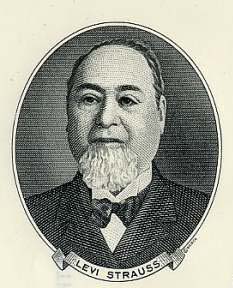 In 1853 at the height of the California Gold Rush, everyday items were in high demand and short supply in San Francisco. A 24-year-old German immigrant, Levi Strauss, left New York and made the journey to California to join his older sister and brother-in-law in running their dry goods store. Upon his arrival, a prospector asked Strauss what he had brought. When told that Strauss had brought canvas for tents and wagons, the prospector told him that he should have brought pants.
In 1853 at the height of the California Gold Rush, everyday items were in high demand and short supply in San Francisco. A 24-year-old German immigrant, Levi Strauss, left New York and made the journey to California to join his older sister and brother-in-law in running their dry goods store. Upon his arrival, a prospector asked Strauss what he had brought. When told that Strauss had brought canvas for tents and wagons, the prospector told him that he should have brought pants.
Levi Strauss had the canvas made into pants. Miners liked the sturdy pants but complained that they tended to chafe and the canvas material never became soft and comfortable. Once the supply of canvas was gone, Strauss began using a thick fabric made in the French town of Nimes known as serge de Nimes. This name would eventually be shortened to denim. Continue reading “Making History: Levi Strauss Patents His Iconic Jeans”
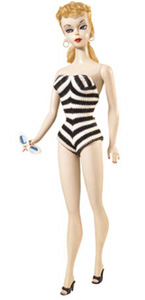 In the mid 1940’s, the young ambitious duo Ruth and Elliot Handler, owned a company that made wooden picture frames. Handler and his partner Harold Mattson built the picture frame samples and it was Ruth’s job to market them. Elliot then decided to use the spare wood to make doll furniture. This began a toy business named Mattel – MATT for Mattson, and EL for Elliot.
In the mid 1940’s, the young ambitious duo Ruth and Elliot Handler, owned a company that made wooden picture frames. Handler and his partner Harold Mattson built the picture frame samples and it was Ruth’s job to market them. Elliot then decided to use the spare wood to make doll furniture. This began a toy business named Mattel – MATT for Mattson, and EL for Elliot.
Ruth noticed that her daughter, Barbara, and her friends enjoyed playing with dolls that looked like grown ups rather than with baby dolls. Most of these dolls were made of paper and were not three-dimensional. Elliot Handler took the idea of such a doll to his all male ad executive team at Mattel. The committee rejected it because they saw little mass appeal for such a doll.
Soon after, on a trip to Europe, Ruth found the German doll Lilli. She was made of hard plastic with molded on shoes, earrings and blonde hair in a ponytail. The doll was offered in a seven or an eleven-inch size. Lilli inspired Ruth to design the Barbie doll. Continue reading “Making History: World’s Most Successful Doll – Barbie”
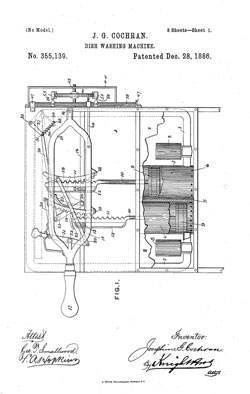 Josephine Cochran was issued Patent No. 355,139 on December 28,1886 for a dish washing machine. Cochran was a wealthy woman in Illinois who frequently hosted dinner parties. She became frustrated when her servants would chip or break her heirloom china so she began washing her own dishes. She was upset with the indignity of having to wash her own dishes and decided that there must be a better way. Since no one else had invented something, she was going to do it herself.
Josephine Cochran was issued Patent No. 355,139 on December 28,1886 for a dish washing machine. Cochran was a wealthy woman in Illinois who frequently hosted dinner parties. She became frustrated when her servants would chip or break her heirloom china so she began washing her own dishes. She was upset with the indignity of having to wash her own dishes and decided that there must be a better way. Since no one else had invented something, she was going to do it herself.
Cochran set to work on her design, staying home from a vacation with her ailing husband. She began by measuring the dishes. She then built wire compartments to fit either cups, plates or saucers. The compartments were placed on a wheel which was turned by a motor inside a watertight metal box. Hot soapy water squirted up in and rained down on the dishes cleaning them. Continue reading “Famous Women Inventors: Josephine Cochran – Dishwasher Patent”
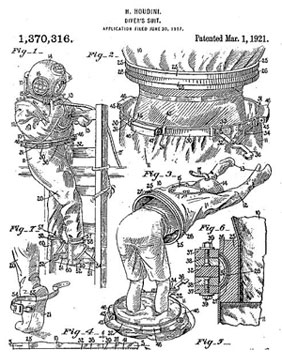 Harry Houdini was born in Budapest, Hungary, to a Jewish family. Houdini began his career as a trapeze artist and was later renowned as a magician and an escape artist. He astonished audiences by escaping from handcuffs, straitjackets, and prison cells.
Harry Houdini was born in Budapest, Hungary, to a Jewish family. Houdini began his career as a trapeze artist and was later renowned as a magician and an escape artist. He astonished audiences by escaping from handcuffs, straitjackets, and prison cells.
Houdini also held a patent for a style of diving suit. The innovation was granted U.S. Patent Number 1,370,316 on March 1, 1921. The object of Houdini’s diving suit was to allow a diver to get out of the suit while submerged. This helped the diver swiftly and safely escape and reach the surface of the water. It also allowed a diver to don his suit without assistance. This was accomplished by being formed in two halves, with a locking joint in the middle. The diver could reach this joint and release it, and then escape from the suit. Continue reading “Making History: Harry Houdini Patents a Diving Suit”
